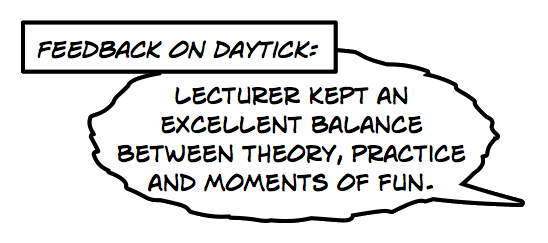Published Tick-the-Code Material
Happy Are The Software Engineers.. (article)
My first ever published article is called "Happy Are The Software Engineers.." and it appeared in Better Software magazine in December 2006. The article describes briefly how complete concentration can create the feeling of happiness especially if the task at hand is meaningful. I wanted to highlight that working for software quality is meaningful and with Tick-the-Code you can achieve complete concentration.
Simply put, happiness is Tick-the-Code.
Tick-the-Code Inspection: Theory and Practice (paper)
My first ever scientific paper is called "Tick-the-Code Inspection: Theory and Practice" and it appeared in the peer-reviewed publication of ASQ (American Society for Quality) called Software Quality Professional.
As the name says, the paper reveals all details of Tick-the-Code up to the 24 coding rules. At the moment this paper is the most comprehensive written source for information about Tick-the-Code.
Tick-the-Code Inspection: Empirical Evidence (on Effectiveness) (paper)
My second paper is called Tick-the-Code Inspection: Empirical Evidence (on Effectiveness). It was prepared for, and first presented at, Pacific Northwest Software Quality Conference 2007. The paper presents measurements taken in Tick-the-Code training courses so far (about 50 sessions with over 300 software professionals). The results are revealing. The main point of the paper is that software engineers could keep their software much simpler and avoid making many of the errors software projects are so notorious for.
In the Appendix of the paper, you'll find all the active rules of Tick-the-Code at the time of writing (summer 2007).
Tick-the-Code - traditionally novel technique in the fight against bugs (article)
Pirkanmaan Tietojenkäsittely-yhdistys (Pitky ry) published my article in their member magazine Pitkyn Piiri 1/2008. It is called "Tick-the-Code - uusvanha tekniikka taistelussa bugeja vastaan" and it is only available in Finnish.
Future Work
Tick-the-Code Inspection: The Book (book, working title)
Since 2006, I'm writing a book on Tick-the-Code to be the most comprehensive written source. I've written first drafts of all chapters, except one. I have received some review comments and acted on them. I have contacted a few publishers and received more comments (no approval yet). O'Reilly editor Andy Oram even mentions us in the Beautiful Code blog. Next, we'll need to get people excited about the concept and the book and then approach the publishers again.
Excerpt from the book
The excerpt changes weekly. Each excerpt is still a draft version and might change before ending in the book.
The thinking is right, though. If you can write code, you should be able to check it, too. Tick-the-Code is essentially a basic skill, which every software developer would be well-advised to master. That is one of the reasons for writing this book, after all. On bad days, I think the premise that you can write software is fallacious, but in most days I blame the non-existent quality training for the sorry state of software development so prominent in many organizations. Tick-the-Code Inspection should be taught everywhere software engineering is taught.
Tick-the-Code is a low-tech approach to code review. It is brain-intensive, focus-inducing and counterintuitive. We could even say that it is taking you back-to-basics, to the grass-root level of the source code. Tick-the-Code is heavy as paper and result-driven. It is at times purely mechanical and sometimes heuristic, all the time puzzling and at best creativity-inspiring. Ticking code free from the shackles of technology can be therapeutic and at the same time both arming and disarming. It is all these things and more.
It can be helpful to describe what Tick-the-Code is not. It isn't reactive. You can't automate it and it isn't just for beginners.
















